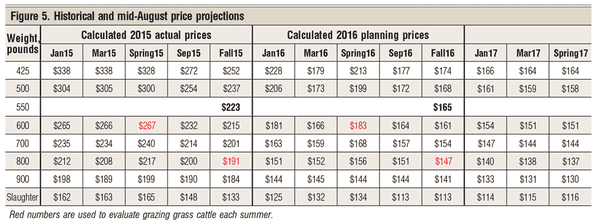4 questions to ask before marketing 2016 calves

What are the four key marketing questions that ranchers need to consider in making their marketing decision for 2016 calves?
What happened in marketing 2015 calves last year?
How are Midwestern corn farmers going to market their 2016 corn crop — through cattle or the local elevator?
What are some projected calf prices for October 2016?
What is the projected profit from backgrounding and/or retained ownership of 2016 calves?
Marketing calves last year
As ranchers think about marketing 2016 calves, it might be worthwhile to review their 2015 marketing strategies. My study eastern Wyoming-western Nebraska rancher marketed his calves in October 2015 for a reasonably good price.
My price analysis shows that the price for these same 2015 calves went down 13% during November 2015, and down 19% from October 2015 to December 2015. Last year, marketing in October made a big difference on the 2015 profits from running a beef cow herd.
What corn farmers might do
As this is being written, there is considerable discussion that corn prices for the 2016 corn crop might be below farmers’ cost of production this fall. If so, Corn Belt farmers could decide that it would be profitable to market their corn through cattle rather than to the local elevator.
If so, these farmer-buyers will show up in local sale barns after corn harvest — say, November to early December. This suggests that 2016 calf prices might strengthen as we progress through the fall marketing season — just the opposite of what happened in 2015.
Projected 2016 calf prices
Let’s first take a look at the western Nebraska sale barn summary for the feeder steer prices as of mid-August 2016 (Figure 1). The price line is the statistical trend line for all the steer calf sales. You can also see the quality impact as the higher-quality steers are priced above the price line and the lower-quality steers prices are below the price line.

If I put the July 2016 price line on the same graph, it goes right on top of the August line, suggesting no change in western Nebraska steer calf prices from mid-July 2016 to mid-August 2016.
The trend of the price line is a minus $26.20 per cwt, representing the constant price slide for feeder steers. It is a bit unusual that the constant price slide fits well over the total weight range.
It is important to note the difference in sale barn steer calf prices in 2016 vs. 2015 (Figure 2). Note the 2015 price line has a more normal curved line as compared with the straight price line in 2016. This suggests a price discount for lightweight feeders in August 2016.

Why? I am not sure. A possible answer might be that since cattle feeders see that the futures market is lower the further out one goes, they want heavier feeders that will finish quicker.
Cattle futures price analysis
My August price analysis of the feeder cattle futures prices shows a different story than my August sale barn price analysis. Futures prices are based on someone’s price expectations. As pointed out in Figure 3, mid-August feeder cattle futures prices are up considerably from mid-July futures. Figure 4 shows the same kind of price increase for live cattle futures prices.


I suspect the market discussions on the potentially lower corn market, plus the fact that feedlots are current now in their marketing, led to these stronger futures markets. Clearly the price increases of these two futures price series are not yet reflected in the western Nebraska sale barn prices presented in Figure 1.
Profit projections for fall 2016 and spring 2017
When all of the above market price information is taken into account, plus my price analysis of corn, my current cattle price projections are presented in Figure 5.

I am projecting that 550-pound weaned steer calves will sell in October 2016 for $165 per cwt. This compares with $223 in October 2015. The bottom line in Figure 5 presents my projected slaughter cattle prices.
Figure 6 presents my current price projections for four traditional marketing alternatives for 2016 calves.
Selling steers and non-retained heifer calves at weaning: Cost of gain for raising calves = $1.53 per pound of calf produced. Marketed in October 2016.
Backgrounding calves in drylot, 569 pounds to 875 pounds. Cost of gain = 60 cents per pound. Marketed in February 2017.
Finish background calves in custom lot, 875 pounds to 1,300 pounds. Cost of gain = 68 cents per pound. Marketed in June 2017.
Grow and finish calves in a custom lot, 569 pounds to 1,300 pounds. Cost of gain = 57 cents per pound. Marketed in May 2017.
Figure 6 also details my projections for my study herd manager. The beef cow profit projection of selling weaned calves is $48 per cow, for a projected earned net return to unpaid labor, management and equity capital of $11,900 for my 250-cow study herd. This is down from $444 per cow earned net income in 2015. Yes, this does suggests an economic need to evaluate alternative marketing strategies.

If these calves were to be sold to the backgrounding enterprise at weaned market price and then backgrounded, my study rancher will add another $11,600 to the $11,900 earned net income at weaning — for a total of $23,500 earned net income from the herd, or $94 per cow.
If these backgrounded calves are custom fed, I am projecting he can add another $3,300 to the total earned net income, or $107 per cow. Maybe, or maybe not, worth the added risk of finishing cattle.
Finally, if these calves are priced into a grow-and-finish custom lot, I project that my study herd can add $172 per head fed — totaling another added $36,300 to the earned net income, for a total net income of $193 per cow. The challenge here is to market the finished animals in May 2017.
If these cattle were to finish in June 2017, I project $52 per head less earned net income — still, $120 per head earned net income is pretty darn good.
So, just as I asked last month, what are your numbers suggesting for your marketing alternatives?
Harlan Hughes is a North Dakota State University professor emeritus. He lives in Kuna, Idaho. Reach him at 701-238-9607 or at [email protected].
You might also like:
Young ranchers, listen up: 8 tips from an old-timer on how to succeed in ranching
13 utility tractors that will boost efficiency in 2016
Burke Teichert: How to cull the right cow without keeping records
3 weaning methods compared; Which one rises to the top?
6 tips for proper electric fence grounding
9 things to include in your ag lease (that you better have in writing!)
About the Author(s)
You May Also Like





